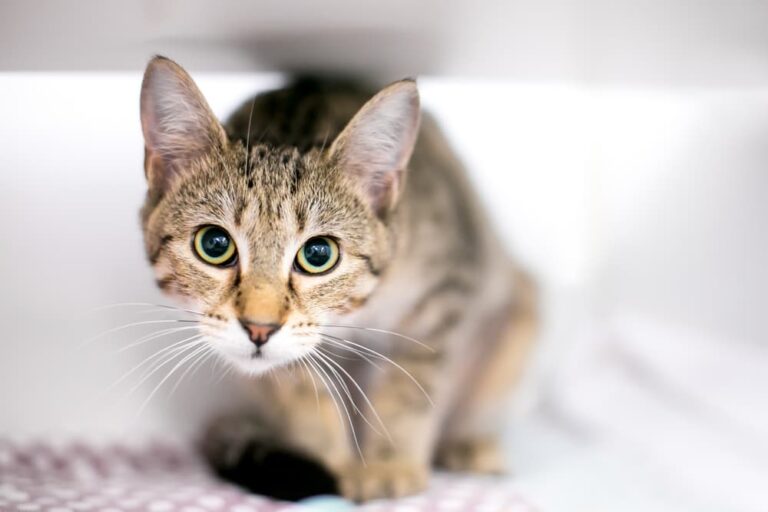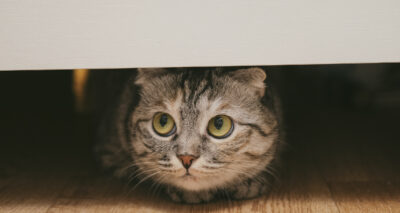Cat Crouching: Why They Do It

Nobody would mistake the Halloween arched-back cat with her hair standing up for a relaxed cat. Unfortunately people often mistake cat crouching behavior as a sign of comfort because they are staying in one place and may close their eyes when you look at them.
Learning to recognize your cat’s emotions through her body and tail language is important for building trust in your relationship, assessing her response to situations, and getting help when she needs it.
The good thing is that cats don’t lie. They may not be upfront about their feelings but if you know how to interpret their cues and signals then you will have a window into their emotional state.
Why Do Cats Crouch?
A crouching cat generally means some kind of discomfort—fear, aggression, or even pain. The rest of their body language and the context of the behavior give us hints as to what your cat is feeling.
For example, a cat crouched with her ears flat and her head low while hiding in the corner is being defensive. She probably feels trapped and wants you to back away. A cat who crouches does not necessarily require a trip to the veterinarian but may benefit from some changes to her environment such as places to hide or moving food somewhere quieter.
It is important to distinguish crouching from a cat who is relaxed but sitting with their feet tucked under them and their ears softly up, as these are signs of comfort. This distinction highlights why it is important to interpret your cat’s body language in the context of her surroundings.
Cat Crouching: What to Look For

Crouching cats have their bodies tucked and their tail wrapped around them. This differs from a relaxed cat who may have her tail out long or splay her body out (for easier petting). Details about her body language including her facial expression and ear position are important for understanding why your cat is crouching.
Defensiveness or Aggression
Cats may take a crouching posture when they feel antagonized. Along with her crouched body, her tail is wrapped around her, her ears are flat, and her eyes are fixed on you. The cat is saying “back off or else.”
Fear or Stress
Her body is crouched and her tail is wrapped, but her ears may be up and her face more relaxed. She may look at you or avert your gaze. She may back away when you come near. She is asking for help because something is making her scared. Do not assume she wants to be picked up to be comforted, but rather try to figure out what is causing her fear or stress so that it can be eliminated.
Pain or Discomfort
This can be the most difficult kind of crouching to interpret because it depends what hurts. Her facial expression may vary depending on how much pain she is in. A cat with abdominal (stomach area) pain may crouch, walk very slowly while staying low to the ground, and not go very far between breaks. A cat with muscle or joint pay may move from her crouched position very slowly and be very careful and deliberate about placing her feet to walk. A cat in pain should always be seen by a veterinarian.
What To Do About Cat Crouching Behavior

If you notice your cat is crouching, start by asking yourself some questions about the behavior. Answering these questions can help you figure out why your cat is crouching and what you can do about it.
Some questions include:
- What else was going on in that situation where your cat was crouching? Did you have friends over, was it storming, or maybe something else? Is it only when there are loud noises?
- How long has your cat been crouching? Is it a new behavior or has she done it for a long time? Did something change in your household at the same time? Have you noticed any other changes in her behavior?
- How often is she crouching? Did it used to be occasional and now it’s more frequent? Is it after playtime or mealtime? Is it anytime someone comes near her or only people wearing heavy shoes?
Asking yourself these and other probing questions may help you come up with a solution. For example, maybe your cat needs more safe spaces to hide. Or maybe she doesn’t want to be touched when the loud dishwasher is running. Eliminating table scraps or a diet change might help if that’s what you can associate with painful crouching. For fear or anxiety, maybe supplements like CBD can help.
If you’re unsure why your cat is crouching, don’t be afraid to ask your veterinarian for help. This is especially true if the crouching is new or increasing in frequency as it could be due to pain or escalating aggression. If you can bring a video of the behavior that will be very helpful.
Your veterinarian will start with a physical exam and you will have the opportunity to talk about tools to make your cat more comfortable in your home, no matter the cause of your cat’s crouching.
Cats give many clues to their emotional state. It is our job as pet parents to learn to read their body language and provide them what they need.









